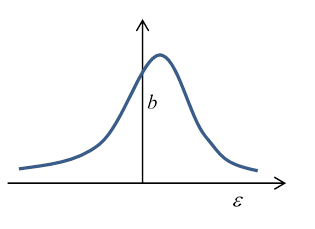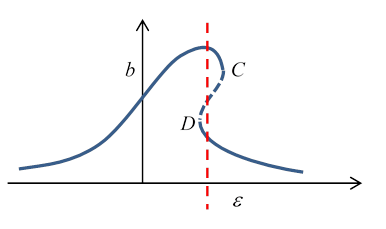1:43 AM Anharmonic Oscillators | |
Anharmonic OscillatorsMichael Fowler IntroductionLandau (para 28) considers a simple harmonic oscillator with added small potential energy terms
(We'll always take We'll do perturbation theory (following Landau):
(Standard practice in most books would be to write We take as the leading term
with the exact value of Putting this correct frequency into the equation gives a nonzero left hand side, so we rearrange. We subtract
Putting Now we can do perturbation theory. The equation for
Notice that the second term on the right hand side includes The key is that there is also a resonant driver in that first term
so the resonant driving terms cancel provided
Remembering
(Actually Note that the frequency increases with amplitude: the Resonance in a Damped Driven Oscillator: a Brief ReviewThe linear damped driven oscillator:
(Following Landau's notation here -- note it means the actual frictional drag force is Looking near resonance for steady state solutions at the driving frequency, with amplitude
For a near-resonant driving frequency
and assuming the damping to be sufficiently small that we can drop the
so the response, the dependence of amplitude of oscillation on frequency, is to this accuracy
(We might also note that the resonant frequency is itself lowered by the damping, but this is another second-order effect we ignore here.)
The half width of the resonance curve as a function of driving frequency For future use, we'll write the above equation for the amplitude in terms of deviation
Damped Driven Nonlinear Oscillator: Qualitative DiscussionWe'll take a damped, driven, nonlinear oscillator, one with a positive quartic potential term, as discussed above:
First, a general discussion. We know from the results above that as the amplitude of oscillations increases, so does the frequency. As previously discussed, an increased oscillation amplitude encounters a potential becoming stronger and stronger than the simple harmonic oscillator. So if we drive the oscillator from rest at the frequency that resonates with its small amplitude oscillations (where the The way to keep the amplitude increasing is evidently to gradually increase the frequency of the driving force to match the natural frequency at the increased amplitude. (Side note: this is the principle of the synchrocyclotron -- except, in that case the frequency is lowered as the energy increases, because the particles go to bigger and bigger orbits as their masses increase relativistically.) This way a small external driving force (enough to overcome frictional damping) can maintain a large amplitude oscillation at a frequency well above the frequency
The bottom line is that for the same external driving force, with frequency in some range above Question: if it's the same driving force, how do you account for the fact that the large oscillation clearly does more work against friction? Answer: the work done by the driving force depends on the phase difference between the force and the motion. It has to be different for the two cases. Nonlinear Case: AnalysisThe equation of motion is:
We established earlier that the nonlinear term brings in an amplitude-dependent correction to the oscillator's frequency:
in Landau's notation. (Actually this The equation for the amplitude in the linear case (from the previous section) was, with
For the nonlinear case, the maximum amplitude will clearly be at the true (amplitude dependent!) resonance frequency
Note that for small enough However, as the driving frequency is further increased, the coefficients of the cubic equation change and at a certain point two more real roots appear.
So what's going on here? For a range of frequencies, including the vertical dashed red line in the figure, there appear to be three possible amplitudes of steady oscillation at one frequency. However, it turns out that the middle one is unstable, so will exponentially deviate, going to one of the other two, both of which are stable. If the oscillator is being driven at its natural frequency, then the driving frequency is gradually increased, it will follow the upper curve to the point If the frequency is now gradually lowered, the amplitude gradually will increase to point Frequency MultiplesThe above analysis is for frequencies not very far from We have Let's define
So
Then, for Similar arguments work for other fractional frequencies. | |
|
| |
| Total comments: 0 | |





 The rate of absorption of energy equals the frictional loss. The friction force
The rate of absorption of energy equals the frictional loss. The friction force 
 But what if we apply this high frequency to a system initially at rest, rather than gradually ramping up in sync with the oscillations? Then for a small driving force, we can treat the system as a damped simple harmonic oscillator, and this off-resonance force will drive relatively small amplitude oscillations.
But what if we apply this high frequency to a system initially at rest, rather than gradually ramping up in sync with the oscillations? Then for a small driving force, we can treat the system as a damped simple harmonic oscillator, and this off-resonance force will drive relatively small amplitude oscillations.


 .
. The
The 